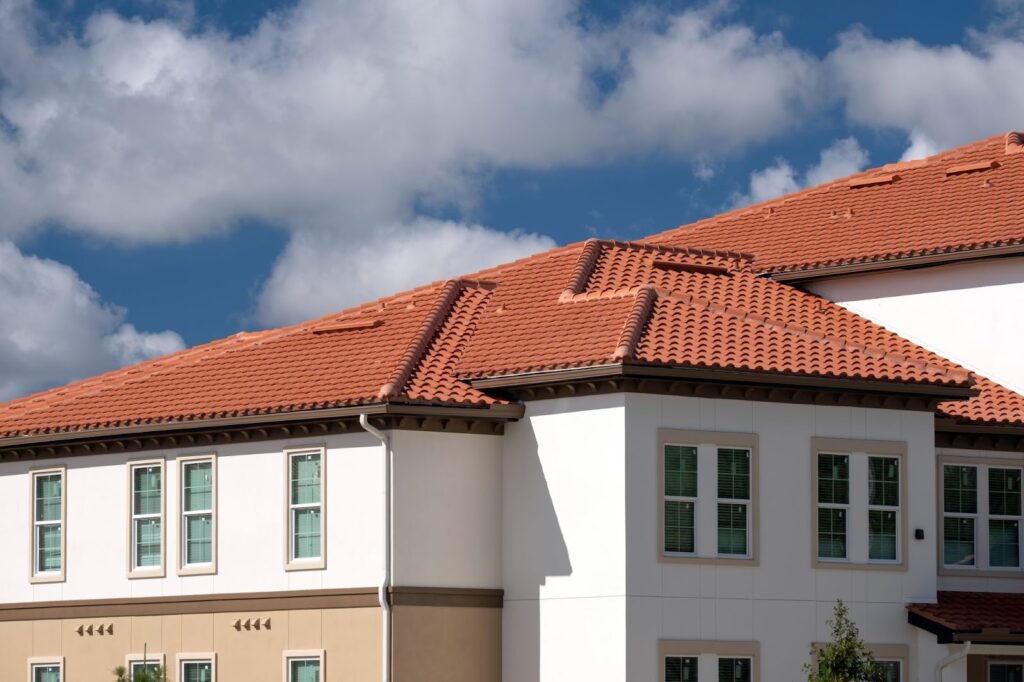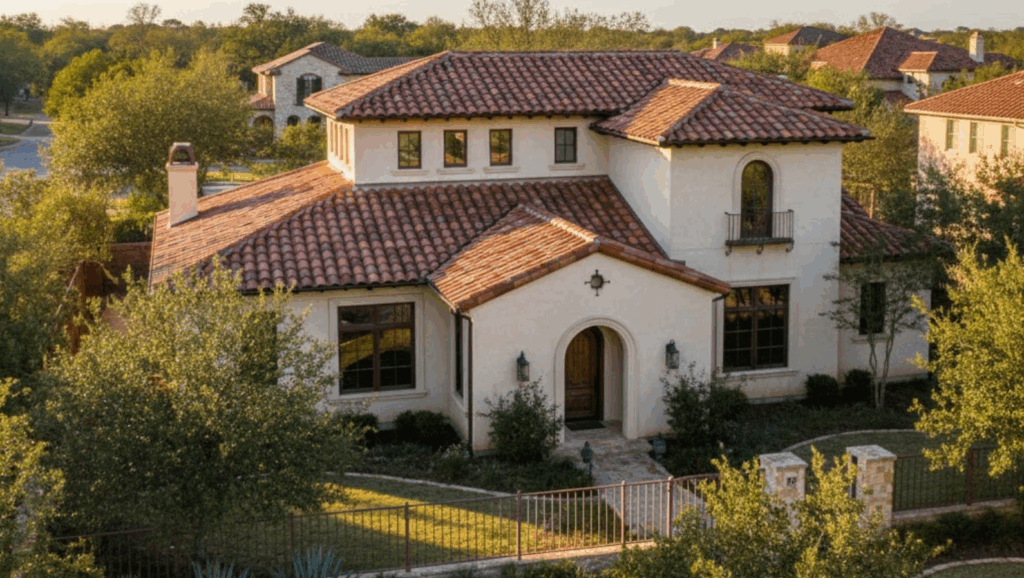Clay tile roofing is an excellent choice for homeowners and business owners in Texas, especially in the challenging climate of DFW. Known for its timeless appeal, exceptional longevity, and fire resistance, clay tile roofing is designed to withstand the region’s sun, wind, and hail. Whether you’re planning a roof inspection or need expert roofing services, Alpine Roofing & Solar is here to help. We specialize in installing, repairing, and restoring roofs that stand up to North Texas weather without compromising on curb appeal.
In this guide, we’ll explore the ins and outs of clay tile roofing, including what it is, how it’s made, the pros and cons, costs, installation best practices, and maintenance tips for DFW’s climate. We’ll also help you choose a trusted contractor. If you’re comparing clay tile with other roofing materials or simply want a roof that will outlast trends, this guide is for you.
What Is Clay Tile Roofing?
Clay tile roofing uses fired natural clay shaped into interlocking tiles. These tiles shed water efficiently and resist both heat and flames. Clay roofing is highly regarded for its classic aesthetics—think Spanish Mission or Mediterranean styles—and is a popular choice for hot climates like North Texas due to its long service life and proven durability.
How Clay Tiles Are Made
The process begins with clay being quarried and refined to remove impurities. The refined clay is then mixed with water and shaped either by extrusion or pressing into molds. After being dried to stabilize, the tiles are optionally glazed for color and surface protection. The tiles are then fired in a kiln at temperatures ranging from 1000–1200°C. This firing process vitrifies the tile, enhancing its density and water resistance, contributing to the durability of the finished product. After firing, the tiles undergo quality checks to ensure consistency in size, color, and strength.
Common Profiles And Styles
- Mission/Spanish (barrel): Convex and concave pieces create that classic wave pattern.
- S-Profile (interlocking barrel): Single-piece tiles with a flowing look.
- Flat/Shingle: Clean-lined, overlaps like shingles but in clay.
- French/Interlocking: Flat tile with pronounced side interlocks for enhanced wind resistance.
Color options range from natural terra cotta and buff to deeper reds and browns, with glazed finishes providing a glossy and long-lasting color.

Clay Vs. Concrete Tile
| Feature | Clay Tile | Concrete Tile |
| Weight | Both are heavy | Concrete is often heavier |
| Longevity | 50–100+ years | ~30–50 years |
| Color | Resists fading | May lighten over time |
| Cost | Higher upfront cost | Typically less upfront |
| Insulation | Better thermal mass | Moderate insulation |
Pros and Cons of Clay Tile Roofing
Clay tile roofing offers several advantages. First, its longevity is a major benefit, with many clay tile roofs lasting 50 to 100 years or more when properly installed and maintained. Additionally, clay tiles offer Class A fire resistance and excellent heat resistance, making them ideal for the hot Texas climate. They require minimal maintenance, especially if installed and flashed correctly, and they provide a timeless, aesthetic appeal that can significantly increase property value. Furthermore, clay is an environmentally friendly material, often recyclable and repairable, making it a sustainable choice for homeowners who value eco-conscious building materials.
However, clay tile roofing does come with a few limitations. One of the most notable is its weight. Clay tiles are quite heavy, often requiring a roof structure that’s designed or reinforced to carry the load. This can increase installation costs, as structural upgrades may be necessary. Another downside is the upfront cost, which is typically higher than that of asphalt shingles or many metal roofing options. Additionally, tiles can crack if walked on improperly or if struck by large hail, requiring careful maintenance. Clay tiles are also not ideal for low-slope roofs, as they generally require a steeper pitch to function effectively.
Costs, Lifespan, And Warranties
Key Cost Factors
The cost of clay tile roofing in DFW varies widely based on tile type, roof complexity, and other factors. As a general estimate, many projects range from $10–$30 per square foot installed. Factors that affect pricing include:
- Profile and finish (standard vs. premium glazed tiles)
- Roof pitch, valleys, penetrations, and story height
- Structural upgrades to support the weight
- High-temperature underlayment and metal flashings (critical in Texas)
- Removal and disposal of the existing roof
Typical Lifespan And Warranty Basics
Clay tile roofs can last 50–100 years when installed properly. Underlayments may need replacement every 20–30 years due to the extreme heat in North Texas, often requiring a lift-and-relay of the tiles. Manufacturer warranties typically range from 30–50 years, while contractor workmanship warranties vary depending on the company and the scope of the project. The installer’s expertise is just as important as the brand of tiles for ensuring long-term warranty success.
Installation Requirements And Best Practices

Roof Structure And Underlayment
Clay tiles are heavy—often weighing 700–900 lbs per roofing square. It’s important to verify that the roof structure can support the weight of the tiles, which may require structural reinforcement. A high-temperature, premium underlayment is also necessary for DFW heat. We install eave starters, hip/ridge systems, and battens (when specified) to ensure proper drainage and ventilation under the tiles.
Flashings, Fasteners, And Ventilation
Texas storms test roof details. We install corrosion-resistant flashings in valleys, walls, and penetrations, use stainless or hot-dipped galvanized fasteners, and follow manufacturer guidelines for wind uplift resistance. Balanced attic ventilation reduces heat and moisture, which helps the entire roofing system last longer.
Maintenance, Repair, And Restoration
Routine Care And Inspections
We recommend annual inspections and additional checks after hail or high winds. Keeping valleys and gutters clear is important to avoid water backup. Minimizing foot traffic on the roof will help prevent tile cracking. If you’re considering adding solar panels, inquire about our detach & reset services to ensure both your panels and tiles are properly coordinated.
Common Repairs
- Replace cracked tiles: Costs depend on access and matching
- Re-flash chimneys/penetrations: Costs vary depending on scope, usually a few hundred to a few thousand dollars
- Underlayment refresh (lift-and-relay): Depending on size and complexity, this can save the tiles while replacing the underlayment
- Ridge/hip system repairs: Costs depend on the extent of the damage
In many cases, restoration is more cost-effective than full replacement because the clay tiles themselves often still have decades of life left. Our team also provides expert restoration services to bring storm-damaged roofs back to life: Restoration Services.
Repair Vs. Replacement: How To Decide
Consider full replacement when structural issues, widespread damage, or outdated underlayment affect the entire roof. Otherwise, targeted repairs or lift-and-relay projects can preserve the tiles and save money.
Selecting A Qualified Roofing Contractor

Credentials, Licensing, And Insurance
Choose a contractor who is licensed, insured, and transparent about safety. Ask about their familiarity with permits, code compliance, and how they protect landscaping during tile work. We are fully certified, insured, and bonded, and we have years of experience helping DFW homeowners navigate complex roof claims and installations.
Tile-Specific Experience And References
Clay tile roofing is a specialty. Ask for recent examples of their work, references, and confirmation of their adherence to manufacturer-approved methods for underlayment, flashing, and fasteners. Be sure to discuss tile sourcing and color matching for consistency.
Ready to vet your project with a tile specialist? Contact Us to schedule an inspection.
FAQs About Clay Tile Roofing
What is the lifespan of clay tile roofing in Texas?
Clay tile roofs can last anywhere from 50 to over 100 years, depending on the installation and maintenance. Regular inspections and proper underlayment can extend the roof’s life.
Is clay tile roofing suitable for all roof pitches?
Clay tile roofs are best suited for steeper slopes. They may not perform well on low-slope roofs.
What maintenance is required for clay tile roofs?
Routine inspections, cleaning gutters and valleys, and checking for cracked tiles are key. If damage occurs, repair or replace individual tiles as needed.
Is clay tile roofing energy-efficient?
Yes, clay tiles provide excellent thermal insulation, helping to keep your home cooler in the summer and warmer in the winter.
How do I know if my home is ready for clay tile roofing?
Clay tile roofs are heavy and require structural reinforcement. We offer a free consultation to assess whether your roof can support the weight of clay tiles.
For estimates, inspections, or answers to quick questions, reach out today: Contact Us. For more details on our expert roofing services in DFW Texas, don’t hesitate to contact Alpine Roofing & Solar or call us directly.
Alpine Roofing & Solar is your trusted roofing company in DFW Texas. We’re located at 7247 Kentish Dr, Fort Worth, TX 76137. For inquiries, call us at +1 682-257-4631 or email info@alpineroofingandsolar.com.
Ready to get started? Explore our roofing services and schedule your inspection now.



